|
 The Origin of Writing:
The Origin of Writing:
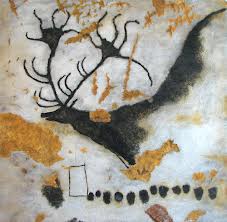 While
it is still generally considered that writing emerged 'independently
in at least three different places - Egypt, Mesopotamia and
Harappa between 3,500 BC and 3,100 BC'
(2),
we have until recently had little understanding of how and why
this happened. The discovery of the Vinca script and (mother)
culture c. 5,500 - 3,500 BC, has offered a possible clue as to
this question, but more importantly, symbols in the Vinca script
can be seen to have roots that trace back as early as
Palaeolithic times, as revealed by the exhaustive examination of
'geometric' symbols in 150 prehistoric caves in France by
Petzinger, 2009. While there is still much work to be done in
order to confirm the hypothesis, it is now suspected that these
Palaeolithic geometric symbols represent a 'proto-script' from
which all other scripts can trace ancestry. While
it is still generally considered that writing emerged 'independently
in at least three different places - Egypt, Mesopotamia and
Harappa between 3,500 BC and 3,100 BC'
(2),
we have until recently had little understanding of how and why
this happened. The discovery of the Vinca script and (mother)
culture c. 5,500 - 3,500 BC, has offered a possible clue as to
this question, but more importantly, symbols in the Vinca script
can be seen to have roots that trace back as early as
Palaeolithic times, as revealed by the exhaustive examination of
'geometric' symbols in 150 prehistoric caves in France by
Petzinger, 2009. While there is still much work to be done in
order to confirm the hypothesis, it is now suspected that these
Palaeolithic geometric symbols represent a 'proto-script' from
which all other scripts can trace ancestry.
Article:
(March, 2010). New Scientist.
'Earliest
Writing Found on 60,000 Year old Eggshells'
New Scientist reports on research published in PNAS about what may be the
earliest writing yet discovered, on eggshells dated to
60,000 years ago. "Since 1999, Pierre-Jean Texier of the
University of Bordeaux, France, and his colleagues have
uncovered 270 fragments of shell at the Diepkloof Rock Shelter
in the Western Cape, South Africa. They show the same symbols
are used over and over again, and the team say there are signs
that the symbols evolved over 5,000 years. This long-term
repetition is a hallmark of symbolic communication and a sign of
modern human thinking, say the team. [Another researcher is
quoted:] 'Judging from what we know about the evolution of art
all over the world, there may have been many [written language]
traditions that were born, lasted for some time, and then
vanished. This may be one of them, most probably not the first
and certainly not the last.'"
(Quick-link)
The concept of
writing in essence, is the transference of thought or language into a
re-readable form. The earliest forms of this art have long been
considered to be represented by pictograms, simple images which
enabled the transfer of information through pictures, but writing
itself has not generally been considered until recently to have
any great antiquity before the flourish of writing witnessed in
the Middle east and Asia c. 3,500 - 3,100 BC. However, modern research is now
questioning this hypothesis with results from different academic
sources confirming the presence of a group of recurring symbols
in Palaeolithic art, suggestive of sharing a common meaning, and
therefore being considered a proto-language.
There have been
several suggestions that the geometric marks, dashes, zigzags
and hatchings etc seen in Palaeolithic art are representative of
a form of communication (e.g.,
Raphael 1945, Leroi-Gourhan 1982,
Marshack 1972,
Lewis-Williams 2002),
but until recently there hasn't been enough research on the
subject to form any concrete conclusions.
Andre Leroi-Gourham, one of the most
respected pre-historians of his generation said at the end of
his life 'At Lascaux I really believe they had come close
to an alphabet'. If he was right that Ice age cultures came to
the brink of developing an alphabet, it would be surprising if
other similar developments didn't take place again until the 4th
millennium BC'.
In 2009, a ground-breaking study by Genevieve
von Petzinger revealed that dots, lines and other geometric
signs found in prehistoric European caves may be the precursor
to an ancient system of written communication dating back nearly
30,000 years. Von Petzinger, with University of Victoria
anthropology professor April Nowell, compiled the markings from
146 different sites in Ice Age France, making it possible to
compare the signs on a larger scale than had ever previously
been attempted.
What made her research �new� was that she was able to use a
whole range of modern technology to compare inventories and
digital images from nearly 150 locations� allowing her the
ability to observe startling similarities among the different
sites studied.

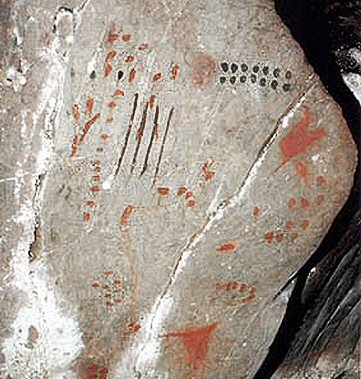
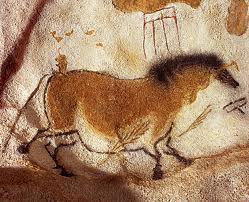
Examples of
Geometric signs in Palaeolithic art.
Building on previous work by other scholars who tended to focus
on the local or regional level, von Petzinger and Nowell were
surprised by the clear patterning of the symbols across space
and time�some of which remained continually in use for over a
period of 20,000 years. The 26 specific signs may provide the
first glimmers of proof that a graphic code was being used by
these ancient humans shortly after their arrival in Europe, or
they may have even brought this practice with them. If correct,
these findings will contribute to the growing body of evidence
that the creative explosion occurred tens of thousands of years
earlier than scholars once thought. Von Petzinger and Nowell�s
findings have been reported in the New Scientist journal
and their research continues to explore the meaning of the
symbols.
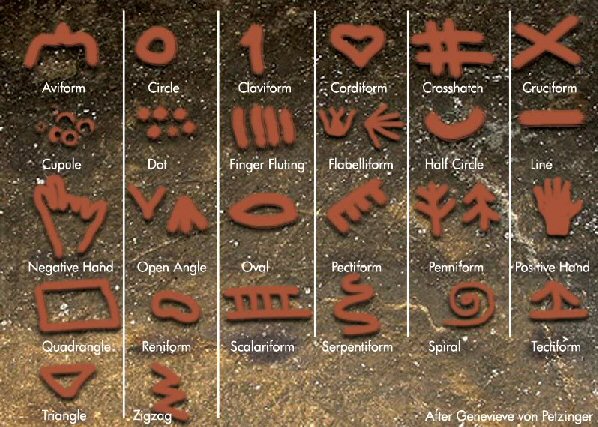
A Chart of
the 26 recurring shapes (proto-alphabet) from the 146
French rock art
sites.
(Quick-link:
The Bradshaw Foundation)
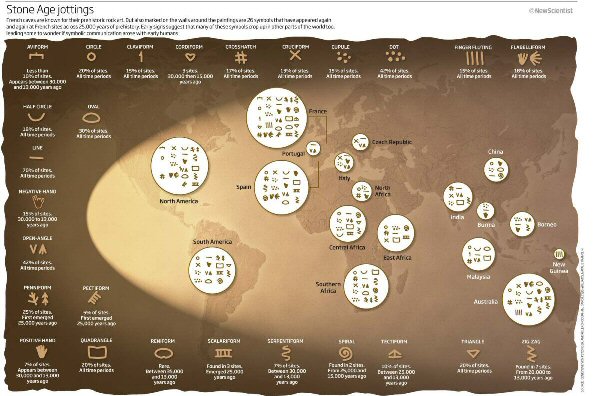
The same symbols are seen in the
National Geographic global comparison of Palaeolithic markings.
(Click on Image for larger view)
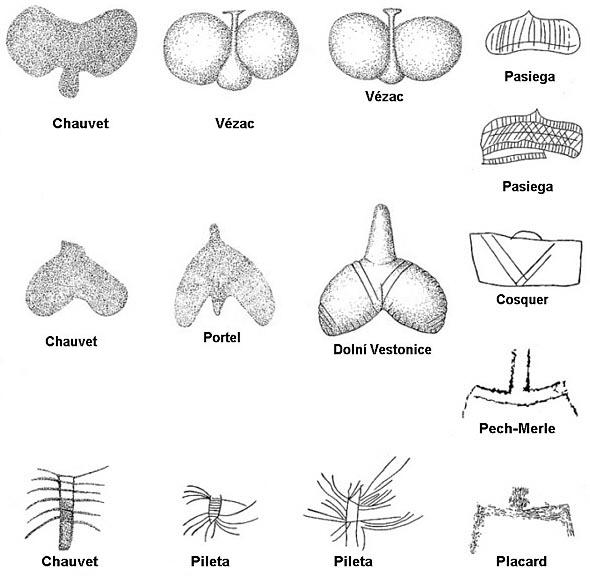
Similarities between symbols at different
Palaeolithic caves in Europe.

A Sample of
similar symbols from Upper Palaeolithic Europe.
(Palaeolithic
Homepage)
|
The Emergence of Alphabet: |
Based on the fact that there are
currently approximately 7,000 known languages whereas, to the best
of our knowledge, fewer than 100 major scripts have appeared in the
course of human history (Lawler 2004), it is argued that alphabetic
scripts have developed only where there is a need for them. In
recognition of this fact, it is important to realise that there is
at least one universal in all known writing systems: they all first
derived the symbols they used from an ancient collective of
images based on animal and natural forms as seen in the Palaeolithic
examples above. It is therefore likely that these iconic symbols,
which can be seen repeated over tens of thousands of years have been
used to convey common meanings throughout time, acting as background
reservoir of constituents for the step from basic pictograms to a
complex alphabet comes hand in hand when the needs of civilisation
demand as shown by the close association between the emergence of
script and the emergence of a 'civilised' state.

In her Plato Prehistorian: 10,000 to 5,000 B.C.
Myth, Religion, Archaeology, Mary Settegast reproduces a table (above) which
shows four runic character sets; a is Upper Palaeolithic (found among
the cave paintings), b is Indus Valley script, c is Greek (western
branch), and d is the Scandinavian runic alphabet.
We are now aware of
the Vinca (Mother) culture which
existed in Eastern Europe around 5,500 - 4,500 BC
(3).
The earliest examples of Vinca script (such as the Vinca Tablets
below) were generally regarded as token or symbolic only however,
following other discoveries with the same symbols in the region, it
is now suspected that the Vinca script represents a proto-language
similar to those from the Great civilisations that emerged a
thousand years later in Egypt, The Middle East and in the Indus
Valley.
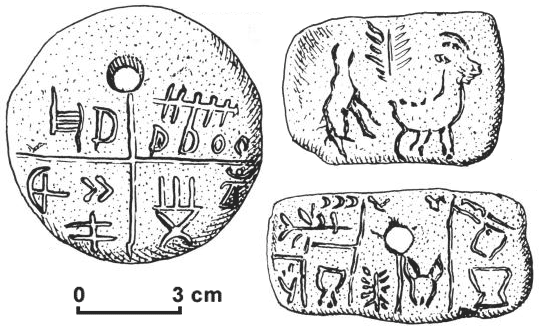
The Vinca tablets c.
5,300 BC (6), are currently the earliest accepted example of
writing.

We can see in the Vinca symbols, a transition form
Palaeolithic iconography to the emergence of a pictographic
language.
(More
about the Vinca Culture)
Richard Rudgley
(4)
proposed that the Old European script emerged from a system of
symbolism rooted in the subconscious of the Neolithic. He said of
it..
'Gimbutas
proposed that it [the Old European Script] was part of a much
wider corpus of signs that expressed cosmological and spiritual
beliefs of the Neolithic age... Gimbautus believed that such
designs were not merely decorative but were elements of an
'alphabet of the metaphysical'.
(4. p72)
The study of such
symbols shows that as the ancient world drew inspiration from the
Neolithic, so too were the first farming communities of this period
drawing inspiration from the symbolic traditions of the
hunter-gatherers who went before them, this finding is enforced by
the work of Alexander Marshack, who documented the persistence of
the zigzag motif in the stone age art of the Upper Palaeolithic
period echoed in the Neolithic
(4). The zigzag also appears
among the old European signs, and its significance can be traced
back to ancient Egypt where the zigzag Hieroglyph means water. Maria Gimbatus found
clear parallels between symbols from different emerging scripts, suggests that the thread of writing
can be traced back to the end of the ice age, suggesting that
writing has been an art that has come and gone in several different
forms throughout time.
The Sacred Art of Writing:
For a long time the
relatively simultaneous emergence of the three great
scripts/civilisations (Indus Valley, Sumerian, Egyptian) c. 3,500 -
3,100 BC has been of interest to academics. The similarities in
script can now been seen to have a connection through the Vinca
culture that went before them. The question of which of the three
scripts/civilisations came first is still in debate, but other
similarities have emerged in relation to the value placed on writing
by these cultures as a 'divine' art, with associations to the gods
and the destiny of mankind which offer a deeper understanding of the
origins of writing, as examination of these traditions reveals a
common thread reaching back to the earliest Palaeolithic attempts to
convey meaning through symbology.
Mythology tells us that the Gods from several different culture
have a divinity said to have given writing to
mankind, such as Sumeria (Mesopotamia), Egypt,
China, India, Greece, Germany and Scandinavia, and
Ireland (with their respective Gods: Nisabu, Thoth, Fuxi, Sarasvati, Hermes, Odin
and Ogma). It is significant that most of these gods
are archetypal divinities known as culture heroes or
culture bearers whose
contributions to humankind have brought other important
benefits to society. For example, in ancient Egypt, the invention
of writing is attributed to the god Thoth, who was not only the scribe and historian of the gods
but also kept the calendar and invented art and science. In some
Egyptian myths, Thoth is also portrayed as the creator of speech
and possessing the power to transform speech into material
objects. This ties in closely with the Egyptian belief that in
order for a person to achieve immortality his or her name must
be spoken or inscribed somewhere forever.
(1)
Extract: 'The value of writing represented
by these gods may be understood within the context
of other values they embody. As Eliade points out,
in archaic cultures each of these acts derives its
value from its association with a divine originator
of the act. Thus, the act of writing itself becomes a form of
participation in the sacred, a ritual act mimicking
an originating original act. If what is
associated with the divine has special value in a
culture, writing must have had a special value and if the cultural value
precedes the projection upon a god, then the god it
is projected upon must bear some characteristics
that the culture associates with writing.
In several cultures, gods of writing were also
gods of wisdom and knowledge. On one level, the
connection between writing and wisdom is obvious,
writing being the means by which the wisdom of a
culture was stored and transmitted., However, there
is more to the link between writing and wisdom than
this obvious reason. Perhaps the most dramatic story
of the possession of wisdom among these gods is
Odin�s, who in the R�natal, a famous passage in the
H�vam�l, narrates the story himself. In his desire
for wisdom, he hung upside down for nine nights on
the World Tree, known as Yggdrasil (Ygg an epithet
for Odin and drasil horse: Odin�s horse), above the
Well of Mirmir located in the roots of the three.
For nine nights he hung there with no food or water,
dying from a wound he inflicted on himself with his
spear. At last, �I peered downward / I grasped the
runes, / screeching I grasped them; / I fell back
from there.� He then �learned nine mighty songs� and
was brought back to life with renewed health and
fertility (Turville-Petre 49-50). The R�natal ends
with the poet referring to Odin�s having written his
own story.
This interpretation of the relationship between
writing and wisdom appears to find support in the
story of how Fuxi created the eight trigrams. Fuxi
is described as observing �images in the skies,�
�patterns on the ground,� and �markings of birds and
beasts and the favorable lie of the land,� all this
in addition to himself, his own body. �And so it
was,� the story goes, �that he created the Eight
Trigrams in order to communicate with the virtue
of divine intelligence and to classify the
phenomena of all living things�. The trigrams were
not images of the things themselves but signs that
provided a connection to the divine source of
knowledge of things. The trigrams provided a source
of communication with the divine that became the
basis for Chinese divination as well as mathematics
and medicine (�Fuxi,� About). Because writing is
said to be derived from these trigrams, it also
seems to participate in this link to divine wisdom'.
(5)
Writing and Divination:
The association
with writing and the gods can be seen to have traditions in
divination. Most of the gods of writing are directly
associated with the fates of individual humans. In some
instances, the fates of humans are literally written by the gods as
a part of their scribal duties and almost all of them are related to
magic and divination.
There are several
examples of the alphabet being used for divination, as seen in the
writing of ones name on leaves in ancient Greece
(7),
divination though the Ogham
alphabet, or alectryomancy,
in where birds peck at letters. One of the standard forms of ritual divination was
casting pebbles or potshards with letters on them. Each letter was
associated with the first word of a predetermined oracle. Robert
Graves speculates that the numerous 'knuckle' dice found at Delphi were alphabetic, casting five dice
with four letters on each, fifteen consonants and five vowels
(Graves, The White Goddess 330-332; see also Halliday 13-16). It is
also possible that the dice has numerical value that were associated
with letters of the alphabet, as in divination with pebbles (Sophistes).
One�s future was literally in the letters.
(5)
(More
about Divination)
Pre Columbian Writing:
With so much
discussion on the origins of writing, it is worth looking at the history of writing in the America's.
Should a Palaeolithic tradition of script be officially recognised, then
one would assume that it carried over to the Americas in the waves of immigration that
occurred following the decline of the last Ice age. A fact which
appears to be evident in the Global survey of Palaeolithic signs
above.
The earliest date for a
proper system of writing came with the Mayans,
who recorded astronomical, etc etc etc. Sadly only 4 codices of an
original estimate of million (ref), are left today, but it is in
their mathematics and astronomy that we find a deeper root in the
inscriptions of pre-Columbian America. The first evidence of
astronomic scripts comes in the form of the 'Long-Count' calendar
system, the earliest evidence of which we have being the 'Cascajal
Block' found in an Olmec setting near
La Venta, and dated c. 900 BC. It is
well known that the Olmecs calendar start date of August 11, 3114
(8),
a fact which is generally brushed off as a coincidence today, but
one with uncanny echoes of the start-date for the emergence of
writing in the Old world.
(More
about the Olmecs)
(Cave
Art)
(Palaeolithic
Homepage)
(The
Vinca 'Mother' Culture)
(Easter
Island/Indus Valley Script)
(List
of Ancient and Sacred Texts)
(Words
of Wisdom Homepage)
|
 While
it is still generally considered that writing emerged 'independently
in at least three different places - Egypt, Mesopotamia and
Harappa between 3,500 BC and 3,100 BC'
(2),
we have until recently had little understanding of how and why
this happened. The discovery of the
While
it is still generally considered that writing emerged 'independently
in at least three different places - Egypt, Mesopotamia and
Harappa between 3,500 BC and 3,100 BC'
(2),
we have until recently had little understanding of how and why
this happened. The discovery of the 







